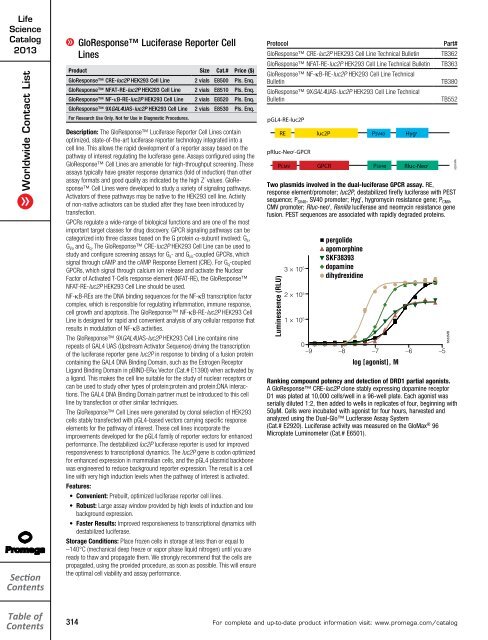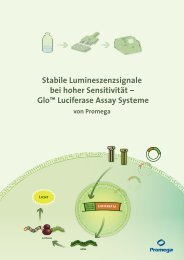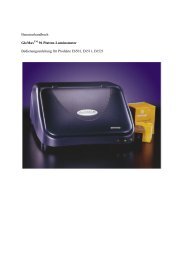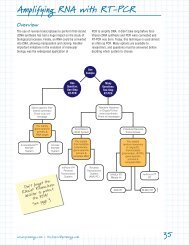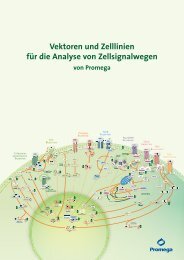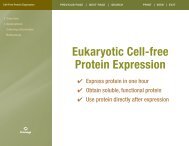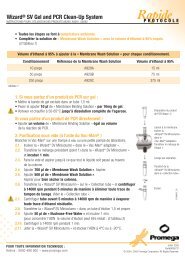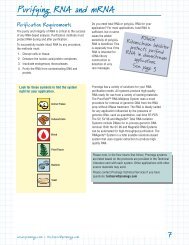2013 Promega catalogue
2013 Promega catalogue
2013 Promega catalogue
You also want an ePaper? Increase the reach of your titles
YUMPU automatically turns print PDFs into web optimized ePapers that Google loves.
Life<br />
Science<br />
Catalog<br />
<strong>2013</strong><br />
Worldwide Contact List<br />
Section<br />
Contents<br />
Cell Signaling<br />
GloResponse Luciferase Reporter Cell<br />
Lines<br />
Product Size Cat.# Price ($)<br />
GloResponse CRE-luc2P HEK293 Cell Line 2 vials E8500 Pls. Enq.<br />
GloResponse NFAT-RE-luc2P HEK293 Cell Line 2 vials E8510 Pls. Enq.<br />
GloResponse NF-κB-RE-luc2P HEK293 Cell Line 2 vials E8520 Pls. Enq.<br />
GloResponse 9XGAL4UAS-luc2P HEK293 Cell Line 2 vials E8530 Pls. Enq.<br />
For Research Use Only. Not for Use in Diagnostic Procedures.<br />
Description: The GloResponse Luciferase Reporter Cell Lines contain<br />
optimized, state-of-the-art luciferase reporter technology integrated into a<br />
cell line. This allows the rapid development of a reporter assay based on the<br />
pathway of interest regulating the luciferase gene. Assays configured using the<br />
GloResponse Cell Lines are amenable for high-throughput screening. These<br />
assays typically have greater response dynamics (fold of induction) than other<br />
assay formats and good quality as indicated by the high Z´ values. GloResponse<br />
Cell Lines were developed to study a variety of signaling pathways.<br />
Activators of these pathways may be native to the HEK293 cell line. Activity<br />
of non-native activators can be studied after they have been introduced by<br />
transfection.<br />
GPCRs regulate a wide-range of biological functions and are one of the most<br />
important target classes for drug discovery. GPCR signaling pathways can be<br />
categorized into three classes based on the G protein α-subunit involved: G s ,<br />
G i/o and G q . The GloResponse CRE-luc2P HEK293 Cell Line can be used to<br />
study and configure screening assays for G s - and G i/o -coupled GPCRs, which<br />
signal through cAMP and the cAMP Response Element (CRE). For G q -coupled<br />
GPCRs, which signal through calcium ion release and activate the Nuclear<br />
Factor of Activated T-Cells response element (NFAT-RE), the GloResponse<br />
NFAT-RE-luc2P HEK293 Cell Line should be used.<br />
NF-κB-REs are the DNA binding sequences for the NF-κB transcription factor<br />
complex, which is responsible for regulating inflammation, immune response,<br />
cell growth and apoptosis. The GloResponse NF-κB-RE-luc2P HEK293 Cell<br />
Line is designed for rapid and convenient analysis of any cellular response that<br />
results in modulation of NF-κB activities.<br />
The GloResponse 9XGAL4UAS-luc2P HEK293 Cell Line contains nine<br />
repeats of GAL4 UAS (Upstream Activator Sequence) driving the transcription<br />
of the luciferase reporter gene luc2P in response to binding of a fusion protein<br />
containing the GAL4 DNA Binding Domain, such as the Estrogen Receptor<br />
Ligand Binding Domain in pBIND-ERα Vector (Cat.# E1390) when activated by<br />
a ligand. This makes the cell line suitable for the study of nuclear receptors or<br />
can be used to study other types of protein:protein and protein:DNA interactions.<br />
The GAL4 DNA Binding Domain partner must be introduced to this cell<br />
line by transfection or other similar techniques.<br />
The GloResponse Cell Lines were generated by clonal selection of HEK293<br />
cells stably transfected with pGL4-based vectors carrying specific response<br />
elements for the pathway of interest. These cell lines incorporate the<br />
improvements developed for the pGL4 family of reporter vectors for enhanced<br />
performance. The destabilized luc2P luciferase reporter is used for improved<br />
responsiveness to transcriptional dynamics. The luc2P gene is codon optimized<br />
for enhanced expression in mammalian cells, and the pGL4 plasmid backbone<br />
was engineered to reduce background reporter expression. The result is a cell<br />
line with very high induction levels when the pathway of interest is activated.<br />
Features:<br />
• Convenient: Prebuilt, optimized luciferase reporter cell lines.<br />
• Robust: Large assay window provided by high levels of induction and low<br />
background expression.<br />
• Faster Results: Improved responsiveness to transcriptional dynamics with<br />
destabilized luciferase.<br />
Storage Conditions: Place frozen cells in storage at less than or equal to<br />
–140°C (mechanical deep freeze or vapor phase liquid nitrogen) until you are<br />
ready to thaw and propagate them. We strongly recommend that the cells are<br />
propagated, using the provided procedure, as soon as possible. This will ensure<br />
the optimal cell viability and assay performance.<br />
Protocol<br />
GloResponse CRE-luc2P HEK293 Cell Line Technical Bulletin<br />
GloResponse NFAT-RE-luc2P HEK293 Cell Line Technical Bulletin<br />
GloResponse NF-κB-RE-luc2P HEK293 Cell Line Technical<br />
Bulletin<br />
GloResponse 9XGAL4UAS-luc2P HEK293 Cell Line Technical<br />
Bulletin<br />
pGL4-RE-luc2P<br />
RE luc2P PSV40 Hyg r<br />
pRluc-Neo r -GPCR<br />
PCMV GPCR PSV40 Rluc-Neo r<br />
Part#<br />
TB362<br />
TB363<br />
TB380<br />
TB552<br />
Two plasmids involved in the dual-luciferase GPCR assay. RE,<br />
response element/promoter; luc2P, destabilized firefly luciferase with PEST<br />
sequence; P SV40 , SV40 promoter; Hyg r , hygromycin resistance gene; P CMV ,<br />
CMV promoter; Rluc-neo r , Renilla luciferase and neomycin resistance gene<br />
fusion. PEST sequences are associated with rapidly degraded proteins.<br />
Luminescence (RLU)<br />
pergolide<br />
apomorphine<br />
SKF38393<br />
3 × 10 5 dopamine<br />
dihydrexidine<br />
2 × 10 5<br />
1 × 10 5<br />
0<br />
–9 –8 –7 –6 –5<br />
log [agonist], M<br />
Ranking compound potency and detection of DRD1 partial agonists.<br />
A GloResponse CRE-luc2P clone stably expressing dopamine receptor<br />
D1 was plated at 10,000 cells/well in a 96-well plate. Each agonist was<br />
serially diluted 1:2, then added to wells in replicates of four, beginning with<br />
50µM. Cells were incubated with agonist for four hours, harvested and<br />
analyzed using the Dual-Glo Luciferase Assay System<br />
(Cat.# E2920). Luciferase activity was measured on the GloMax ® 96<br />
Microplate Luminometer (Cat.# E6501).<br />
6632MB<br />
5251MA<br />
Table of<br />
Contents<br />
314<br />
For complete and up-to-date product information visit: www.promega.com/catalog


